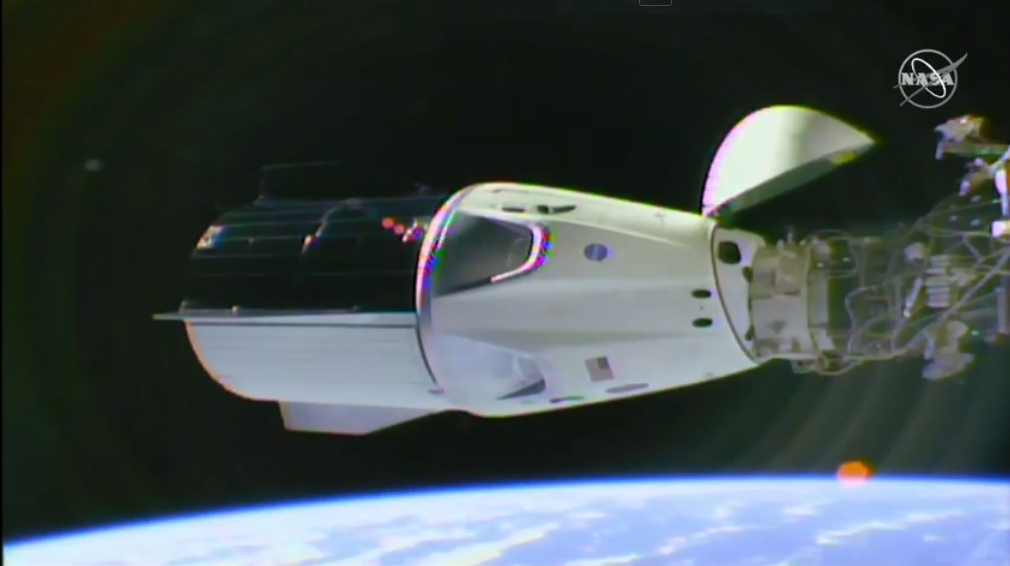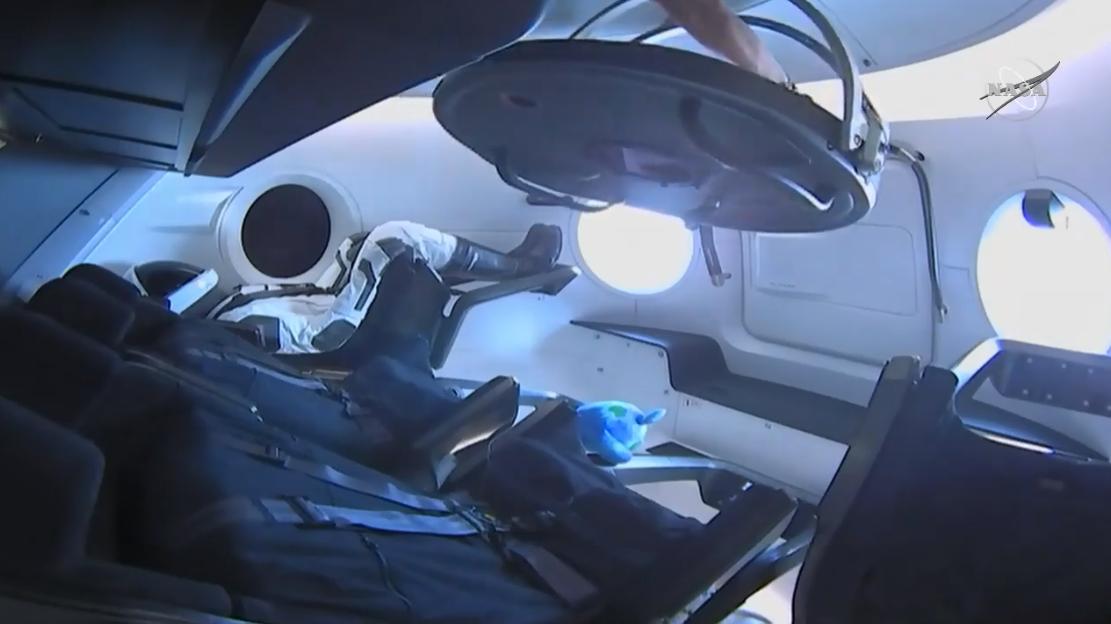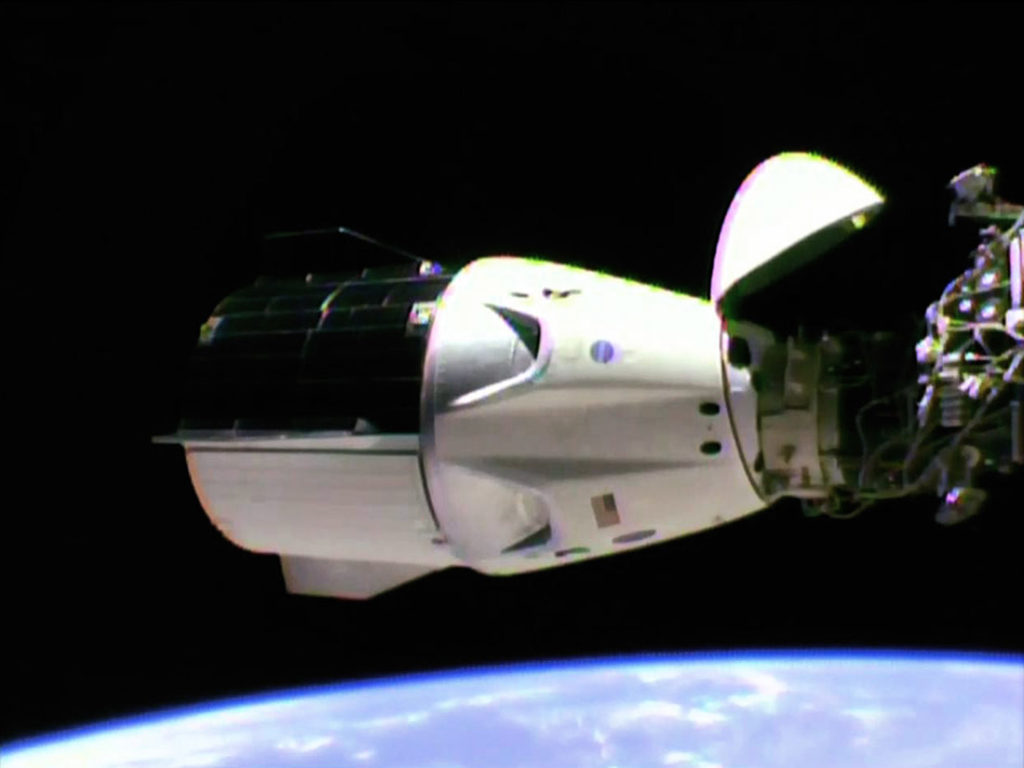SpaceX's Crew Dragon Docks at Space Station for First Time
SpaceX's new astronaut taxi just checked off another huge milestone on its maiden orbital flight.
The Crew Dragon capsule successfully docked with the International Space Station this morning (March 3) at 5:51 a.m. EST (1051 GMT), about 27 hours after launching into orbit from NASA's Kennedy Space Center (KSC) on Florida's Space Coast. Dragon linked up with a docking port on the station's Harmony module as the two craft sailed 250 miles (402 kilometers) over the Pacific Ocean, just north of New Zealand.
"Congratulations to all the teams on a successful docking," NASA astronaut Anne McClain radioed Mission Control from aboard the space station. She and her Expedition 58 crewmates, David Saint-Jacques of Canada and Oleg Konenko of Russia, followed the docking closely.
Related: SpaceX Dragon Crew Demo-1 Test Flight: Full Coverage





Applause broke out at SpaceX's control center in Hawthorne, California, as Crew Dragon secured itself to the station with a set of hooks and latches. At 8:07 a.m. EST (1307 GMT), the station crew opened the hatch to Crew Dragon for the first time and floated inside, with SpaceX beaming live views of the capsule's interior, where the dummy astronaut Ripley and a Celestial Buddies Earth plush toy awaited the astronauts.
"Everything looks great," McClain told Mission Control after looking inside Crew Dragon through a hatch window just before the crew entered. "Ripley and Earth both look like they enjoyed their trip up here."
Crew Dragon will spend the next five days attached to the orbiting lab, eventually ending its uncrewed shakeout cruise, which is known as Demo-1, with a parachute-aided splashdown in the Atlantic Ocean on Friday morning (March 8).
Breaking space news, the latest updates on rocket launches, skywatching events and more!
The spacecraft docked itself at the space station in a first for SpaceX, whose cargo-only versions of the Dragon spacecraft had to be captured by a robotic arm controlled by astronauts and then attached to the station. Crew Dragon docked itself at a new parking spot on the station called an International Docking Adapter.
Weeeee! Looks like the @CelestialBuddy is having a blast up there 😮🚀#CrewDragon (gif cred: @stevespaleta) pic.twitter.com/IMYVQ4BO4JMarch 3, 2019
"This is unbelievable news for everyone here at SpaceX and at NASA," SpaceX software engineer Tom Praderio said during live NASA TV commentary from SpaceX's mission control center.
NASA astronaut Bob Behnken, who will fly on Demo-2 — the first Crew Dragon mission to carry humans — later this year, watched the docking in SpaceX's control center with his crewmate Doug Hurley.
"It's was just super-exciting to see it," Behnken said on NASA TV. "Just one more milestone that gets us ready for our flight coming up here."
Demo-1's main goal is to show that the capsule can carry NASA astronauts to and from the International Space Station (ISS) safely. SpaceX has been developing Crew Dragon under a $2.6 billion NASA commercial-crew contract, which the agency awarded in 2014.
Crew Dragon is based on SpaceX’s robotic Dragon freighter, which has flown 16 ISS resupply missions to date under a separate NASA deal. But a successful docking today was far from guaranteed, because the two vehicles have very different ISS arrival strategies: Cargo Dragon is grappled by the orbiting lab’s huge robotic arm, whereas Crew Dragon docks directly to the station.
Indeed, SpaceX founder and CEO Elon Musk singled out docking as a potentially troublesome component of the Demo-1 mission.
"That’s certainly going to be something new, that we haven’t done before," Musk told reporters yesterday (March 2) during a post-launch news conference at KSC.
And Crew Dragon isn’t out of the Demo-1 woods yet. The most difficult part may come at the very end of the test flight, when the capsule comes barreling back into Earth’s atmosphere.
"I see hypersonic re-entry as probably my greatest concern," Musk said. He cited Crew Dragon’s newly re-designed parachute system and its backshell, which is asymmetrically shaped rather than smoothly conic like that of the cargo Dragon.
That revised backshell performs very well in SpaceX’s re-entry computer simulations, Musk said, but it has yet to be ground-truthed (or air-truthed, rather).
Related: SpaceX's Crew Dragon Demo-1 Test Flight in Pictures
If Demo-1 ends as well as it started, SpaceX should soon be ready to launch a "high-altitude abort test" using this same Crew Dragon capsule. That flight will prove out the spacecraft’s emergency-escape system, which is designed to get astronauts out of harm’s way in the event of a problem during launch.
After that will come a huge milestone — the Demo-2 mission, which will send NASA astronauts Bob Behnken and Doug Hurley to the ISS. That flight is currently targeted for July — eight years after the last crewed orbital spaceflight to launch from U.S. soil, the STS-135 mission of the space shuttle Atlantis.
Ever since NASA’s shuttle fleet was grounded, the agency has been dependent on Russian Soyuz spacecraft and rockets to ferry its astronauts to and from the orbiting lab. The commercial-crew deal with SpaceX, and a similar one NASA signed with Boeing in 2014, was designed to end that reliance on a foreign power.
Under its $4.2 billion deal, Boeing is developing a capsule called the CST-100 Starliner, which could launch on its first mission, an uncrewed ISS flight similar to Demo-1, as early as next month.
- SpaceX Launches Historic Crew Dragon Test Flight to Space Station for NASA
- Take a Walk Through SpaceX's Crew Dragon Spaceship
- SpaceX Dragon Crew Demo-1 Test Flight: Full Coverage
Space.com managing editor Tariq Malik contributed to this report. Mike Wall's book about the search for alien life, "Out There" (Grand Central Publishing, 2018; illustrated by Karl Tate) is out now. Follow him on Twitter @michaeldwall. Follow us on Twitter @Spacedotcom or Facebook.

Michael Wall is a Senior Space Writer with Space.com and joined the team in 2010. He primarily covers exoplanets, spaceflight and military space, but has been known to dabble in the space art beat. His book about the search for alien life, "Out There," was published on Nov. 13, 2018. Before becoming a science writer, Michael worked as a herpetologist and wildlife biologist. He has a Ph.D. in evolutionary biology from the University of Sydney, Australia, a bachelor's degree from the University of Arizona, and a graduate certificate in science writing from the University of California, Santa Cruz. To find out what his latest project is, you can follow Michael on Twitter.

